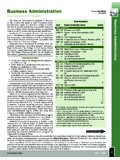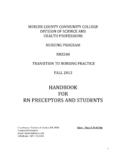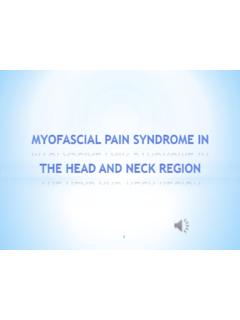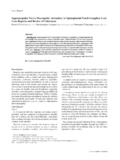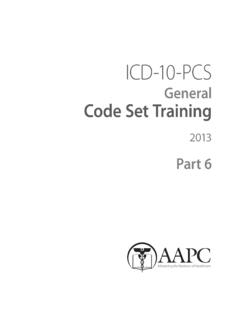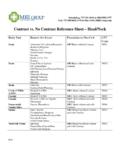Transcription of THE KNEE - Mercer County Community College - MCCC
1 PTA 216 THE KNEE Comprised of 2 joints Tibiofemoral patellofemoral Dutton, 2012. pg. 513 THE KNEE Movement occurs in 2 planes Sagittal Flexion Extension Transverse Internal Rotation (IR) External Rotation (ER) Dutton, 2012. pg. 513 KNEE ANATOMY Dutton, 2012. pg. 514 LIGAMENTS OF THE KNEE Dutton, 2012. pg. 514 LIGAMENTS OF THE KNEE Dutton, 2012. pg. 515 THE KNEE Susceptible to injury due to the positioning of the joint 2 long levers meeting at the joint and stabilized by ligaments Magee, 2008. pg. 727 Patello-Femoral Syndrome Deviations of patellar tracking throughout knee f lexion and extension causing pain and inf lammation Patient may report pain with: Ascending/descending stairs Squatting Kneeling Transferring from sit to stand *Most common in women secondary to an increased Q-angle Dutton, 2008.
2 Pg. 798 Patello-Femoral Syndrome Rehabilitation includes: Stretching the hamstrings Modalities as needed Strengthening the quadriceps (specifically the VMO) Strengthening the hip ABDuctors and hip f lexors Bracing and/or taping as needed Chondromalacia of the Patella Softening of the cartilage of the knee, usually following injury Characterized by edema, pain, and degenerative changes Rehabilation includes: decreasing pain and inf lammation, increasing strength & f lexibility Dislocation of the Patella Occurs when the patella fully dislocates from within the trochlear groove of the femur, resting outside of the knee joint First dislocation is a pre-disposition to further dislocations secondary to the tearing of the medial patello-femoral ligament (MPFL) Treatment Strengthening, stabilizing, and bracing Trochlear Groove Dislocation of the Patella Surgical intervention Lateral Release.
3 The tight lateral structures are cut to allow better anatomic positioning of the patella in the trochlear groove Cautious movement in knee f lexion is initiated early to prevent scarring down of the released structures Shankman, 2011. pg. 281 Trochlear Groove Rehabilitation Process Control of pain and inf lammation Early stretching Gentle strengthening Manual patellar stretching Osteochondritis Dissecans Joint disease in which a piece of cartilage and neighboring bone tissue become detached from the articular surface Symptoms: Pain Clicking in the joint Tenderness Edema Stiffness Osteochondritis Dissecans Conservative treatment is usually successful: Rest Immobilization Anti-inf lammatory medication Modified activity (approx.)
4 6-8 weeks) Physical Therapy: stretching, ROM, strengthening exercises and low impact cardiovascular activity *Surgical intervention would include stabilization and/or removal of fragments Fracture of the Tibial Plateau Most commonly: direct trauma (fall) Less commonly: a rotational injury Displaced or non-displaced Treatment Conservative early ROM, limited weight bearing, gentle strengthening as indicated by physician ORIF Shankman, 2011. pg. 283 Ligamentous Injuries Common injuries of the knee can vary significantly in severity Can occur straight plane with rotation Graded according to severity Ligamentous Injuries Anterior Cruciate Ligament (ACL) Result of ER, valgus stress, internal tibial rotation and possibly hyperextension Posterior Cruciate Ligament (PCL) Result of posteriorly directed trauma Shankman, 2011.
5 Pg. 263, 270 Ligamentous Injuries Medial Collateral Ligament (MCL) Result of valgus force, ABDduction, or rotation Lateral Collateral Ligament (LCL) Result of varus force Shankman, 2011. pg. 272 Grading of Ligamentous Injuries: Grade I: Incomplete stretching of the ligament Minimal pain, minimal to no edema, no loss of function, and no clinical instability Shankman, 2011. pg. 263 Grading of Ligamentous Injuries: Grade II: partial loss in ligament fiber continuity, some ligament fibers are torn although the majority of fibers are intact Moderate pain and edema with minimal loss of function and joint stability Shankman, 2011.
6 Pg. 263 Grading of Ligamentous Injuries: Grade III: complete tearing of all ligament fibers with no continuity noted Significant pain and edema with loss of function and joint stability *Please note that edema /pain associated with a Grade III sprain will usually subside in approximately 3-4 days Shankman, 2011. pg. 263 Ligament Reconstruction: 2 types of grafts used for reconstruction purposes Autograft: tissue harvested from the body of the patient Hamstring, Achilles, patellar, quadriceps Allograft: tissue harvested from the body of a donor (usually from a cadaver) Autograft (quadriceps tendon) Allograft (patellar tendon and Achilles tendon) Dutton, 2012.
7 Pg. 530 meniscal Injuries Meniscus: cartilagenous tissue which serves as an extension of the tibia providing support of the femoral condyles on the surface of the tibia Functions of the meniscus: *Stability *Shock Absorption *Load transmission *Control of motion *Nutrition *Lubrication Shankman, 2011. pg. 274 meniscal Injuries: Mechanism of injury: Trauma (usually a combination of knee f lexion, rotation, compression, and shear) Gradual degeneration: subtly with no specific injury meniscal Injuries: Injuries are marked by edema, catching and/or locking within the joint Management of these injuries is based upon the severity and location of the tear Surgical Treatment: removal of the damaged portion of the meniscus Non-surgical Interventions: decrease pain and inf lammation, increase strength and increase joint stability Shankman, 2011.
8 Pg. 276 Examples of meniscal Injuries Knee Arthroplasty Removal of the articular surface of the tibia and femur (occasionally includes the patella) and replacing them with metal or plastic Primary indications for total knee arthroplasty (TKA) include: Osteo-arthritis (OA) Degenerative Joint Disease (DJD) Shankman, 2011. pg. 285 Patellar Apprehension Test Patient lies supine with the test leg relaxed in approximately 30 degrees of f lexion. The examiner places both hands on the medial border of the patella. The patient remains relaxed with no quadriceps contraction while the examiner gently pushes the patella laterally.
9 Patellar Apprehension Test This test is considered positive if: the patient contracts the quadriceps or reacts apprehensively to the test. Indicative of: patellar subluxation and/or dislocation Cook, 2013. Apley Compression Test The patient lies prone test knee f lexed to 90o The examiner stands proximal hand on the patient s forefoot the distal hand on the patient s heel The tester medially and laterally rotates the tibia while applying a downward pressure through the heel. Apley Compression Test Positive finding: Pain, clicking, or movement restriction indicating a medial or lateral meniscus tear (depending on location of symptoms) Konin, 2006.
10 Pg. 310 Clarke s Test With the patient in supine with knees supported The tester places the web of the thumb on the superior border of the patella applies a downward and inferior pressure on the patella The patient is asked to contract the quadriceps muscle Pain and/or inability to complete the test are indicative of chondromalacia of the patella Konin, 2006. pg. 255 Godfrey 90/90 Test The patient is supine on a plinth with the hip and knee of the involved side f lexed to 90o stabilize the position of the patient s hip and knee while observing the location of the tibia if the tibia is resting more inferiorly on one side, it may indicate a posterior cruciate sag, which would indicate possible PCL injury Cook, 2013.
